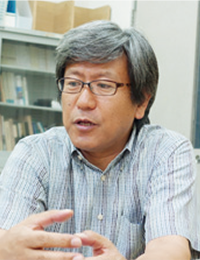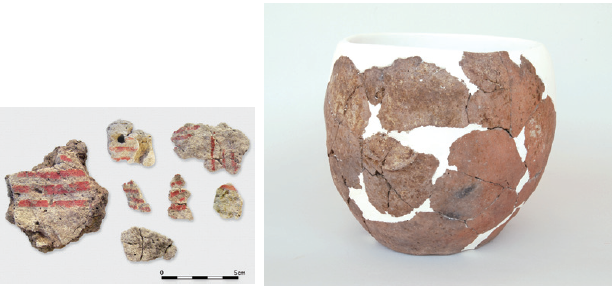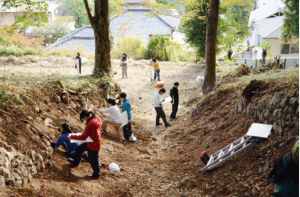キーワード: 考古学、パイロテクノロジー、石灰プラスター、土器
http://rcwasia.hass.tsukuba.ac.jp/kaken/index.html
 「パイロテクノロジー(pyrotechnology)」という言葉を聞いたことがありますか? あまり聞きなれないこの言葉は、加熱による化学変化を利用する技術の総称です。例えば、土器、ガラス、金属器のほか、石灰や石膏を用いた建築材料も、パイロテクノロジーです。旧石器時代の約250万年という長い間、素材を叩いて割り、形を変えて道具にする、という方法でモノづくりをおこなってきた人類ですが、今から約1万年前の新石器時代にパイロテクノロジーを発達させます。今の鉄鋼業など、近代産業に続く技術の原点、パイロテクノロジーに着目し、技術史の観点から人類の歴史の解明に挑戦しているのが「古代の技術史」リサーチユニットです。
「パイロテクノロジー(pyrotechnology)」という言葉を聞いたことがありますか? あまり聞きなれないこの言葉は、加熱による化学変化を利用する技術の総称です。例えば、土器、ガラス、金属器のほか、石灰や石膏を用いた建築材料も、パイロテクノロジーです。旧石器時代の約250万年という長い間、素材を叩いて割り、形を変えて道具にする、という方法でモノづくりをおこなってきた人類ですが、今から約1万年前の新石器時代にパイロテクノロジーを発達させます。今の鉄鋼業など、近代産業に続く技術の原点、パイロテクノロジーに着目し、技術史の観点から人類の歴史の解明に挑戦しているのが「古代の技術史」リサーチユニットです。
先端技術を用いて古代技術を解明
パイロテクノロジーの資料は、時代も地域も多岐にわたっているため、これまでそれらのつながりについて総合的な研究が行われることはほとんどありませんでした。しかし、それをパイロテクノロジーという視点を軸に、技術どうしのつながりや、新しい技術との関連などを見直すことで、これまでとは少し違う視点で理解できるようになってきます。たとえば、もっとも古いパイロテクノロジーのひとつである土器にはいくつか起源があると考えられており、日本も含めた東アジアの土器は紀元前1万3千年ころ、西アジアでは紀元前7千年ぐらいに出現します。環境や生活様式の差が土器の必要性、その結果としての技術の発達度合に影響を与えたのではないか、と予想されていましたが、出土した土器を質量分析などの先端技術を用いて解析することで、いままではわからなかった土器の用途や交易活動など新しい事実も明らかになってきました。(図1)。

図1:トルコの新石器時代の遺跡から出土したプラスター片(左)、および、復元された土器(右)
筑波大学の歴史、史料を最大限に活用する

図2:旧葛生町(くずうまち)での実習風景(江戸時代後期の石灰焼成窯)
パイロテクノロジーは、先史時代に起こった大きなモノづくりの変化です。筑波大学には、前身である東京教育大学の時代から、西アジア、アフリカ、南アジア、中央アジアにおいて調査を進めてきた実績があります。調査の過程で得られたこれら貴重な資料は、新たな歴史研究の地平を切り開くことを目的に利用されています。また、リサーチユニットメンバーが教鞭をとる筑波大学人文学類では、先史学実習の一環として石灰の町である旧葛生町(くずうまち)の石灰焼成施設を対象に調査も行っています(図2)。これらの活動をつうじ、地域や時代の枠ををこえ、パイロテクノロジーをキーワードに、人類のモノづくりの歴史を探っていけたら、と考えています。
社会への貢献・実績
● 西アジア先史時代の技術に関連する新たな資料発掘に貢献
取材:平成26年7月2日
Pyrotechnology-based research to explore the history of humans’ manufacturing
Unit name: History of Ancient Technology
Key words: archaeology, pyrotechnology, lime plaster, pottery
 Have you ever heard of the term “pyrotechnology”? Most people have probably not. It is the collective term for technologies that utilize chemical changes caused by heating. Not only pottery, glass, and metal objects, but also building materials made of lime and gypsum are produced using pyrotechnology. Throughout the Paleolithic period of approximately 2.5 million years, people were making tools by chipping and pecking materials and changing them into different forms, and pyrotechnology was developed at the onset of the Neolithic period, approximately 10,000 years ago. The research unit: “History of Ancient Technology”, focused attention on pyrotechnology – the origin of technology that led to the development of modern steel and other industries, to take on the challenges of examining human history from the viewpoint of technological history.
Have you ever heard of the term “pyrotechnology”? Most people have probably not. It is the collective term for technologies that utilize chemical changes caused by heating. Not only pottery, glass, and metal objects, but also building materials made of lime and gypsum are produced using pyrotechnology. Throughout the Paleolithic period of approximately 2.5 million years, people were making tools by chipping and pecking materials and changing them into different forms, and pyrotechnology was developed at the onset of the Neolithic period, approximately 10,000 years ago. The research unit: “History of Ancient Technology”, focused attention on pyrotechnology – the origin of technology that led to the development of modern steel and other industries, to take on the challenges of examining human history from the viewpoint of technological history.
Research on ancient technology using advanced technologies
Few comprehensive studies have been conducted to examine relationships among pyrotechnology-related materials because they were created in many different periods and regions. However, reviewing relationships among technologies or between conventional and new technologies based on the standpoint of pyrotechnology helps us understand these objects from different perspectives. For example, pottery – one of the oldest products of pyrotechnology, is considered to have several origins: pottery in East Asia, including Japan, and West Asia dates back to B.C. 13,000 and 7,000, respectively. In the past, the necessity of pottery and the level of technological development, as its result, in different areas and eras were considered to be influenced by different environments and ways of life. In recent years, new insights on the functions of pottery and trading activities have been obtained by conducting mass spectrometry based on advanced technologies (Figure 1).

Figure 1: Pieces of plaster (left) and restored pottery (right) found at a Neolithic site in Turkey
Making the best use of the history of the University of Tsukuba and its historical materials

Figure 2: A scene of training in former Kuzuumachi (lime kilns in the late Edo period)
Pyrotechnology is a major shift in manufacturing that occurred in prehistoric times. The University of Tsukuba has been conducting research in West, South, and Central Asia and Africa since the time the school was referred to as the Tokyo University of Education. Valuable information and materials acquired from surveys are utilized to pave the way for new historical studies. At the College of Humanities of the University of Tsukuba, research unit members serve as teaching staffs, conduct surveys of lime kilns in former Kuzuumachi – a town of lime, as part of practical training on prehistory. We continue these activities, using pyrotechnology as the keyword, to explore the history of manufacturing across different areas and periods.
Social contributions and achievements
– Contribution to the excavation of materials related to technologies in prehistoric West Asia
Interviewed on July 2, 2014
